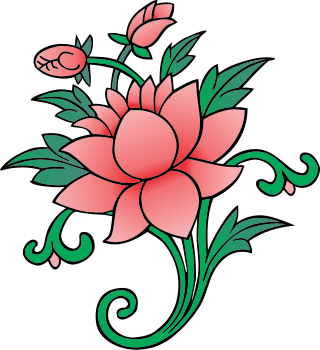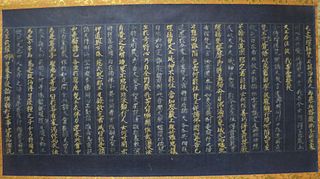
The Dragon King, also known as the Dragon God, is a Chinese water and weather god. He is regarded as the dispenser of rain, commanding over all bodies of water. He is the collective personification of the ancient concept of the lóng in Chinese culture.

The Mahāyāna sūtras are a broad genre of Buddhist scripture (sūtra) that are accepted as canonical and as buddhavacana in Mahāyāna Buddhism. They are largely preserved in Sanskrit manuscripts, and translations in the Tibetan Buddhist canon and Chinese Buddhist canon. Several hundred Mahāyāna sūtras survive in Sanskrit, or in Chinese and Tibetan translations. They are also sometimes called Vaipulya ("extensive") sūtras by earlier sources. The Buddhist scholar Asaṅga classified the Mahāyāna sūtras as part of the Bodhisattva Piṭaka, a collection of texts meant for bodhisattvas.

The Sutra of Perfect Enlightenment or Complete Enlightenment is a Mahāyāna Buddhist sūtra highly esteemed by both the Huayan and Zen schools. The earliest records are in Chinese, and it is believed to be of Chinese origin.

The Heart Sūtra is a popular sutra in Mahāyāna Buddhism. In Sanskrit, the title Prajñāpāramitāhṛdaya translates as "The Heart of the Perfection of Wisdom".

The Chinese Buddhist canon refers to a specific collection of Chinese language Buddhist literature that is deemed canonical in Chinese, Japanese, Korean, and Vietnamese Buddhism. The traditional term for the canon is "Great Storage of Scriptures". The concept of the Chinese Buddhist canon was influenced by the Indian Buddhist concept of a Tripitaka, literally meaning 'three baskets' - sutras, Vinaya, and Abhidharma. However, Chinese Buddhists historically did not have access to a Tripitaka of Indian Buddhist texts. Rather, individual texts were brought to China individually or in small batches and translated one-by-one. This led to the creation of a distinct Chinese Buddhist canon.

In Buddhism, an āgama is a collection of early Buddhist texts.

The Saṃyutta Nikāya is a Buddhist scriptures collection, the third of the five Nikāyas, or collections, in the Sutta Pitaka, which is one of the "three baskets" that compose the Pali Tipitaka of Theravada Buddhism. Because of the abbreviated way parts of the text are written, the total number of suttas/sūtras is unclear. The editor of the Pali Text Society edition of the text made it 2889, Bodhi in his translation has 2904, while the commentaries give 7762. A study by Rupert Gethin gives the totals for the Burmese and Sinhalese editions as 2854 and 7656, respectively, and his own calculation as 6696; he also says the total in the Thai edition is unclear. The suttas/sūtras are grouped into five vargas/vaggas, or sections. Each varga/vagga is further divided into samyuttas/saṃyuktas, or chapters, each of which in turn contains a group of suttas/sūtras on a related topic.

The Yulanpen Sutra, also known as the Ullambana Sutra, is a Mahayana sutra concerning filial piety. It was translated from an Indic language and is found in Taisho 685 and Taisho 686 in Volume 16, the third volume of the Collected Sutra Section. Taisho 685 was translated by Dharmarakṣa from 265-311 CE and is entitled: 'The Buddha Speaks the Yulanpen Sutra'. Taisho 686 was translated by an unknown or lost translator during the Eastern Jin Dynasty and is entitled: 'The Buddha Speaks the Sutra of Offering Bowls to Repay Kindness'. According to Karashima, Taisho 686 is basically a more idiomatic adaptation of Taisho 685. It records the events which followed after one of the disciples of Shakyamuni Buddha, Maudgalyayana, achieves Abhijñā and uses his newfound powers to search for his deceased parents. In the end, Maudgalyayana finds his mother in the preta world and with the assistance of the Buddha, is able to save her. The East Asian Ghost Festival is based on this sutra.

The Śūraṅgama Sūtra is a Mahayana Buddhist sutra that has been especially influential on Korean Buddhism and Chinese Buddhism. It was particularly important for Zen/Chan Buddhism. The doctrinal outlook of the Śūraṅgama Sūtra is that of Buddha-nature, Yogacara thought, and esoteric Buddhism.

The Amitāyurdhyāna Sūtra (Sanskrit); simplified Chinese: 佛说观无量寿佛经; traditional Chinese: 佛說觀無量壽佛經; pinyin: Fóshuōguānwúliàngshòufójīng; Vietnamese: Phật Thuyết Kinh Quán Vô Lượng Thọ Phật; English: Sutra on the Visualization of [the Buddha] Immeasurable Life) is a Mahayana sutra in Pure Land Buddhism, a branch of Mahāyāna Buddhism.
The Sutra of Forty-two Chapters is often regarded as the first Indian Buddhist sutra translated into Chinese. However, this collection of aphorisms may have appeared some time after the first attested translations, and may even have been compiled in Central Asia or China. According to tradition, it was translated by two Yuezhi monks, Kasyapa Matanga (迦葉摩騰) and Dharmaratna (竺法蘭), in 67 CE. Because of its association with the entrance of Buddhism to China, it is accorded a very significant status in East Asia.
Buddhabhadra was a Mahayana Buddhist meditation and Vinaya master. He is most known for his prolific translation efforts of Buddhist texts from Sanskrit into Chinese, and was responsible for the first Chinese translation of the Avataṃsaka Sūtra in the 5th century. In China he is often known as the "Meditation Master from India" (天竺禪師).

The Innumerable Meanings Sutra also known as the Sutra of Infinite Meanings is a Mahayana buddhist text. According to tradition, it was translated from Sanskrit into Chinese by Dharmajātayaśas, an Indian monk, in 481, however Buswell, Dolce and Muller describe it as an apocryphal Chinese text. It is part of the Threefold Lotus Sutra, along with the Lotus Sutra and the Samantabhadra Meditation Sutra. As such, many Mahayana Buddhists consider it the prologue to the Lotus Sutra, and Chapter one of the Lotus Sutra states that the Buddha taught the Infinite Meanings just before expounding the Lotus Sutra.

The Brahmajāla Sūtra, also called the Brahma's Net Sutra, is a Mahayana Buddhist Vinaya Sutra. The Chinese translation can be found in the Taishō Tripiṭaka. The Tibetan translation can be found in Peking (Beijing) Kangyur 256. From the Tibetan it was also translated into Mongolian and the Manchu languages. It is known alternatively as the Brahmajāla Bodhisattva Śīla Sūtra.
The Qingjing Jing is an anonymous Tang Dynasty Taoist classic that combines philosophical themes from the Tao Te Ching with the logical presentation of Buddhist texts and a literary form reminiscent of the Heart Sutra. It instructs students of the Tao to practice the elimination of desire in order to cultivate spiritual purity and stillness.

Yunju Temple is a Buddhist temple located in Fangshan District, 70 kilometers (43 mi) southwest of Beijing and contains the world's largest collection of stone Buddhist sutra steles. Yunju Temple also contains one of only two extant woodblocks for the Chinese Buddhist Tripitaka in the world as well as rare copies of printed and manuscript Chinese Buddhist Tripitakas. It also has many historic pagodas dating from the Tang and Liao Dynasty.
The Humane King Sutra is found in Taisho No. 245 and 246. Many scholars have suspected this sutra to be composed in China but not all scholars agree with this viewpoint. There are two versions: the first is called the Humane King Perfection of Wisdom Sutra (仁王般若波羅蜜經), while the second is called the Humane King State-Protection Perfection of Wisdom Sutra (仁王護國般若波羅蜜經), more idiomatically the Prajnaparamita Scripture for Humane Kings Who Wish to Protect their States. Both sutras are found in the prajnaparamita section of the Taisho Tripitaka.
The Bequeathed Teachings Sutra, or the Sutra on the Buddha's Bequeathed Teaching and Bequeathed Sutra is a brief Mahayana sutra containing instructions left by the Gautama Buddha before His said final nirvana. It is reportedly translated by Kumārajīva into Chinese around 400 C.E.

The Yiqiejing yinyi is the oldest surviving Chinese dictionary of technical Buddhist terminology, and the archetype for later Chinese bilingual dictionaries. This specialized glossary was compiled by the Tang dynasty lexicographer and monk Xuanying (玄應), who was a translator for the famous pilgrim and Sanskritist monk Xuanzang. When Xuanying died he had only finished 25 chapters of the dictionary, but in 807 another Tang monk named Huilin (慧琳) compiled an enlarged 100-chapter version bearing the same title.

The Yiqiejing yinyi 一切經音義 "Pronunciation and Meaning in the Complete Buddhist Canon" was compiled by the Tang dynasty lexicographer monk Huilin 慧琳 as an expanded revision of the original Yiqiejing yinyi compiled by Xuanying 玄應. Collectively, Xuanying's 25-chapter and Huilin's 100-chapter versions constitute the oldest surviving Chinese dictionary of Buddhist technical terminology. A recent history of Chinese lexicography call Huilin's Yiqiejing yinyi "a composite collection of all the glossaries of scripture words and expressions compiled in and before the Tang Dynasty" and "the archetype of the Chinese bilingual dictionary".













